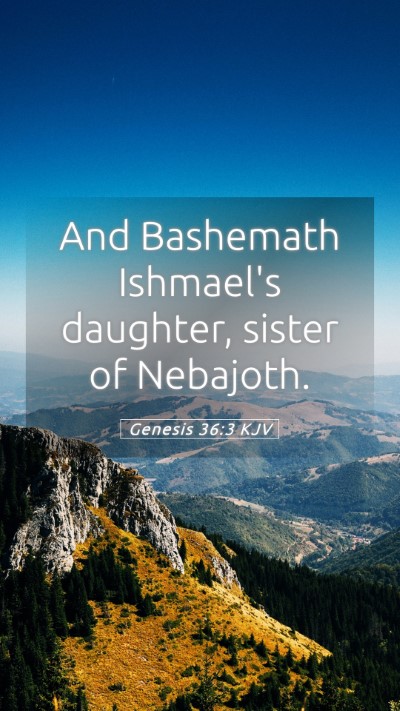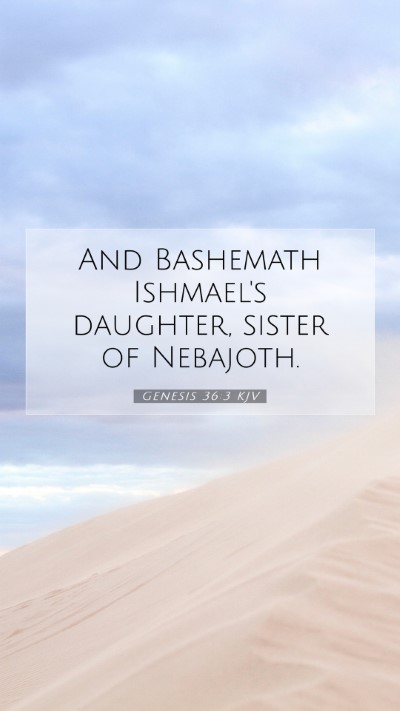Bible Verse Meaning of Genesis 36:3
Genesis 36:3 states, "And Bashemath, Ishmael’s daughter, sister of Nebajoth." This verse identifies the family lineage associated with Esau, providing insights into his relationships and marriages.
Understanding Genesis 36:3
In this verse, the mention of Bashemath as the daughter of Ishmael holds significant historical and theological implications, as it connects Esau directly to the lineage of Abraham. This union not only emphasizes the familial ties between different tribes but also highlights the conflicts that arise from these relationships.
Commentary Insights
- Matthew Henry's Commentary: Henry emphasizes the importance of Esau's choices in marriage, which reflected his disregard for the covenantal family lineage established through Isaac and Rebecca. He notes that marrying into Ishmael's family represents a departure from the intended path for God's chosen people.
- Albert Barnes Commentary: Barnes points out that Bashemath’s connection to Ishmael indicates how Esau's lineage intertwines with that of Ishmael, highlighting the ongoing rivalry between these two families. This marriage represents not only a familial bond but also foreshadows future conflicts between the descendants of Isaac and the descendants of Ishmael.
- Adam Clarke's Commentary: Clarke provides historical context regarding Ishmael and his descendants. He notes that Esau’s selection of a wife from Ishmael's lineage speaks to the broader theme of the ongoing struggle for inheritance and blessing, a recurring element in the narrative of Genesis.
Bible Verse Interpretations
The marriages of biblical characters often serve to underline greater themes within their respective narratives. In the case of Genesis 36:3, the choice of Esau's wife from Ishmael’s family signifies the blurring of lines between the covenant community and those outside of it. This mixture created tensions that are seen throughout the Scriptures.
Historical Context
The historical context surrounding Genesis 36:3 is crucial for understanding its implications. At this point in Scripture, Esau, the son of Isaac, becomes a significant figure representing those outside the covenant promises made to Abraham. Here, the mention of Ishmael’s lineage serves as a reminder of Abraham's other son, whose descendants would also play a vital role in the biblical narrative.
Relevance in Modern Bible Study
This verse illustrates the need for careful Bible study insights that consider historical context and cultural backgrounds. The choices of biblical figures, such as Esau, are often reflections of greater spiritual truths and conflicts that can be applied to contemporary life.
Application of Genesis 36:3
The significance of Genesis 36:3 can be applied as follows:
- Reflect on Choices: Just as Esau's marriages reflected his priorities, believers today are encouraged to examine their own choices and their alignment with God’s will.
- Covenantal Relationships: The importance of family ties and their covenantal nature is profound. This verse serves as a reminder of the commitment that comes with marriage and family.
- Understanding Rivalries: Recognizing the ongoing conflicts from these marriages helps one understand the difficulties that arise in familial relationships today.
Cross References
- Genesis 25:12-18: This passage elaborates on the descendants of Ishmael.
- Genesis 27:39-40: This discusses Esau's fate and his relationship with his descendants.
- Genesis 28:9: Here, Esau's further decisions regarding marriage are examined.
Conclusion
In summary, Genesis 36:3 provides a brief yet profound glimpse into the lives of Esau and his family dynamics. Understanding this verse involves recognizing its theological and historical implications which enrich the Bible verse commentary experience. Engaging with such scripture prompts believers to contemplate their own Biblical exegesis and application in life.
For those seeking deeper meanings of Bible verses, Genesis 36:3 stands as a testament to the complexity of human relationships and God’s unfolding plan throughout history.


